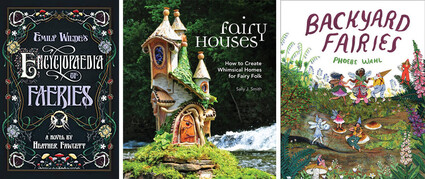Faeries
The TALE: Tehachapi Art, Literature and Entertainment
March 18, 2023
I sometimes ponder on how to say enough about a book I review without giving away too much. It's always a precarious balance, enticing the reader into the story while leaving enough yet to be found. This week I am in a conundrum because the topic of my main book is fairies, or faeries in the author's choice of spelling. Do you believe in faeries?
I chose the new publication "Emily Wilde's Encyclopedia of Faeries," a novel by Heather Fawlett, because it is March and I like to reference the festivities of Irish folklore as we celebrate our own version of St. Patrick's Day. The main character in the book, Emily Wilde, is so caught up in faerie lore that I find it difficult to find my razor edge and right tone to tell you about her faeries. So I will proceed with the expectation that like Emily, you already believe in faeries and that her job as a Dryadology professor at Cambridge University is deemed as natural a study as economics, medieval literature or chemical engineering.
Emily embarks on her expedition of fieldwork to the uppermost lands of Norway and the village of Hrafnsvik in Ljosland. The freighter cuts through rough seas dodging icebergs, and seasickness is a given during the journey. Emily is the only passenger who steps onto the small dock and no one is there to greet her. With her dog Shadow, an unknown breed almost the size of a small horse, she hauls her heavy trunk through the village, watched by the both curious and distrustful eyes of the townsfolk. She receives no greetings or help.
The small cottage she has rented does not greet her warmly either, being the size of a postage stamp and even colder inside than outside. But Emily is used to rough quarters on her expeditions. Finishing her dissertation is her goal along with publishing her encyclopedia of faeries, the first of its kind. In order to be complete, she must investigate this farthest island of Norway and its specific variety of faeries. Only then can she be published and hopefully accepted into her community of scholars as an equal.
Now, to review your faerie knowledge. Faeries are most often thought to be Irish. Actually they maintain a worldwide footprint, having journeyed and immigrated for thousands of years. Faeries favor nectar, honey and berries. They can be tempted with sweets and shiny objects. Fae is another name for faerie, meaning trust or belief, and there are half fae (half human half faerie), the dark fae who are evil (Maleficent in Sleeping Beauty). Pixies are faes with wings, and the whole faerie community across the world only speaks two languages, Bast and Felurian. Males give birth with a three month gestation period and most faeries have green eyes with their blood flowing red to black.
Greeting faeries can be very tricky and it's important to know that if a faerie asks your name and you give it, you are giving them power over you. If you find out a faerie's name and say it aloud, they will leave you alone. Saying thank you can both please or anger a faerie, depending on the situation, and also make them disappear.
It says in the book, "The fact is that you will never hear a faerie unless they wish to be heard." Fortunately, Emily intrigues faeries and she is very good at luring them into showing themselves. In the surrounding mountains, Emily gathers new knowledge for her book, and finds herself part of a dangerous adventure. Shadow is always her greatest protector. Wendell Bambelby, a colleague from Cambridge, arrives unexpectedly from England bearing his own agenda and is not fully welcomed. He is a mystery, added to the mix of challenges that include a terrifying changeling and the continuous faerie abduction of children from the village.
Can Emily help the villagers with her broad faerie knowledge? Can Emily help Bambelby on his personal quest? Can they gain the trust of local faeries and protect themselves from harm? Will Emily's encyclopedia ever be completed? Those are the questions the reader will ponder as they take this journey with a variety of faeries bearing both good and evil intentions.
Do we have faeries in our Tehachapi mountains? There is a way to find out. Build a faerie house yourself and see if you can temp one into your yard with sweets, berries and perhaps shiny bits of stone. Don't put out metal objects though. The ones with iron can burn a faerie's skin terribly, while only the purest silver is safe. "Fairy Houses" by Sally J. Smith would be a good reference book on how to create your own faerie area. "Backyard Fairies" by Phoebe Wahl is a wonderful and creative picture book you can share with your children. And faerie doors? We didn't even get to discuss those. Just beware of any door that may show up unexpectedly and anywhere, inside or outside, and enter at your own risk. I hope I have given you enough information to keep you safe and more than enough to tempt you!
Good Books. Good reading.
*Midge Lyn'dee is a fictional character used for the purpose of entertainment though the reviews are real and sincere.





